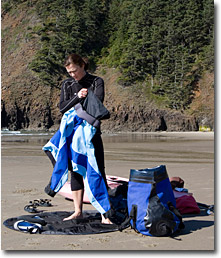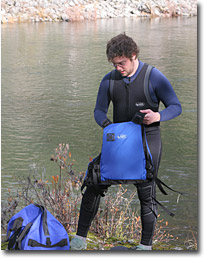How to Prevent Heat Loss with Paddling Layers
Understanding the mechanisms of heat loss, and gain, helps us plan strategies for regulating that loss so we stay safe and comfortable. First, one basic fact: Technically, there is no such thing as “cold”. Cold is simply a lack or deficit of heat, relative to some norm. One generally accepted norm is the average human body core temperature of 98.6°F (37°C). When the core temperature drops significantly below that, we become “hypothermic” or are said to be suffering from hypothermia.
Heat energy flows from warm objects to other objects that are less warm, or “colder”. Nature is always seeking a balance of temperatures. Drop an ice cube in a glass of warm water. The heat in the water is transferred to the ice, melting it. The result is water cooler than the original water, yet warmer than the temperature of the ice cube.
Mechanisms of Heat Loss
We lose heat from our bodies in four ways: radiation, conduction, convection and evaporation. Much of the info in this section comes from Hypothermia, Frostbite and Other Cold Injuries by Gordon G. Giesbrecht, Ph.D and James A. Wilkerson, M.D. This is an excellent book, written in layman’s language, on this very technical medical subject.
Radiation
 This is the energy transported in the form of electromagnetic waves or radiation. Two easily recognized sources of this energy are the sun and a bonfire. Standing outside on a sunny day or next to a fire, you readily feel the heat from these radiation sources. Well, your body is also a radiant heat source and radiation is usually our largest source of heat loss. Giesbrecht and Wilkerson state, “In a calm, temperate climate of about 70°F (21°C) clothed, sedentary persons lose approximately 60 percent of their body heat through radiation.”
This is the energy transported in the form of electromagnetic waves or radiation. Two easily recognized sources of this energy are the sun and a bonfire. Standing outside on a sunny day or next to a fire, you readily feel the heat from these radiation sources. Well, your body is also a radiant heat source and radiation is usually our largest source of heat loss. Giesbrecht and Wilkerson state, “In a calm, temperate climate of about 70°F (21°C) clothed, sedentary persons lose approximately 60 percent of their body heat through radiation.”
It’s hard to prevent radiation heat loss. So called “space blankets” and items like the SOL Escape Bivvy Sack use a reflective material to bounce this radiation back to the body. We add fine particles of titanium, a reflective metal, to the adhesive that bonds the inner fabric layer in our neoprene wetsuits, gloves, footwear, etc to help reflect back body heat. Since it’s hard to limit radiation heat loss, we must concentrate on limiting the other heat loss sources.
Conduction
This is the direct transfer of heat away from the body by substances with which it comes in direct contact. Air isn’t very dense and is a poor heat conductor. The main heat conducting substance that boaters come in contact with is water. Water conducts heat some 25 times more efficiently than air. If you go for a swim, that water is sucking heat away from you at a very rapid rate. And you don’t have to be in direct contact with the water to feel the effect. As kayakers know, cold water outside the hull of their boat is a real heat sink, rapidly chilling an unprotected lower body.
Convection
Convective heat loss occurs when water or air that is cooler than the body contacts it, is warmed by the body and moves away. The heat that warmed the air or water is lost and cooler air or water that replaces it must in turn be warmed, increasing heat loss.
A simple example of this is blowing on a cup of soup or coffee to cool it down. The air above the cup is warmed just above its surface. Blowing moves that air away and cooler air comes in to replace it, extracting more heat from the cup.
Convective heat loss is very extreme in moving river water. When you go for a swim with a swift current, water is conducting heat away 25 times more efficiently than air, and the moving water is sweeping away the warmed water around you.
Even when you are not in the water, convection cools your body. While air is a poor conductor, moving air sucks away heat efficiently—thus the “wind chill effect”. With wind the amount of heat lost increases as the square of the velocity. Therefore, a wind of 8 mph removes four-times as much heat as a wind of 4 mph.
Evaporation
For us boaters, this is the changing of liquid water to water vapor, which requires heat in making the transformation. It takes 0.58 calories (food calories or kilocalories) of heat to evaporate one gram of water. One ounce of water equals 28 grams. One cup of water equals 224 grams. You get the picture. You’re out on the water getting hit by splash and rain, plus the wind is blowing. Lots of heat is getting sucked away.
Preventing Heat Loss for Boaters
As mentioned earlier, it’s hard to reduce radiation heat loss, so we’ll concentrate on reducing the other three. Let’s first look at insulation.
A good insulator is one that restricts the flow of heat through it. How does heat flow? Other than by electromagnetic radiation, it flows by one molecule exciting the molecule next to it, ad infinitum. The less dense the material, the less efficient the heat transfer. A vacuum is a perfect insulator; that’s great in a thermos but impractical in clothing.
However, still (or dead) air is a great insulator. That’s why goose down works so well. Those fluffy feathers trap lots of still air and greatly retard the flow of heat. However, down isn’t a practical insulating material for boaters because once it gets wet, the down feathers clump together and most of the air space is eliminated.
Neoprene
 One form of insulation that works for boaters is neoprene foam. Neoprene is a synthetic rubber containing millions of tiny pockets, filled with nitrogen gas, that are formed during the manufacturing process. These pockets of gas, along with the relatively low density rubber, slow the transfer of heat through the material. And, as mentioned earlier, we add titanium particles to the adhesive layer to help reduce radiation heat loss. The article, “NRS Terraprene Neoprene,” gives more information on the material we use for most of our neoprene wetsuits, footwear, gloves, etc.
One form of insulation that works for boaters is neoprene foam. Neoprene is a synthetic rubber containing millions of tiny pockets, filled with nitrogen gas, that are formed during the manufacturing process. These pockets of gas, along with the relatively low density rubber, slow the transfer of heat through the material. And, as mentioned earlier, we add titanium particles to the adhesive layer to help reduce radiation heat loss. The article, “NRS Terraprene Neoprene,” gives more information on the material we use for most of our neoprene wetsuits, footwear, gloves, etc.
Neoprene is used mostly in wetsuits and other “non-dry” apparel. These garments are designed to fit snugly to the body, so when water enters, it’s only a thin layer that gets warmed by your body. The snug fit is very important; a loose fit allows water to surge in and out of the suit, creating convective heat loss.
Synthetic Fibers
The more common ones include nylon, polypropylene (polypro), polyethylene and polyester. The yarns can be made in various shapes and sizes and woven into patterns that create loft and air pockets for insulation. The individual fibers do not absorb water so they efficiently wick moisture away from your body. When they do get wet, they retain a lot of their insulating properties and dry quickly.
Wool
Wool is an amazing natural fiber. The individual fibers have a crimp texture that forms tiny air pockets for good insulating values. It wicks body moisture efficiently and can hold up to 30% of its weight in water without feeling wet. Even wet, it still insulates and it doesn’t hold odor. Merino wool is in a category all its own. The extra-fine diameter fibers make a soft, stretchy fabric that is non-itchy.
Cotton
Never wear cotton or cotton-blend garments for layering protection. Cotton fibers readily absorb water and when wet lose all insulating properties. And it dries very slowly.
Outer Layers
Your outer layers, generally referred to as technical outerwear, are very important players in preventing heat loss, in several ways. Almost all of our gear in these categories have a waterproof, breathable membrane or coating (the Rio tops and bottoms are waterproof, but non-breathable). They help keep your base layers dry in two ways—by preventing outside water from getting into your insulating layers and allowing your body moisture to pass through. The outer fabric also has a durable water repellant (DWR) treatment that makes water bead up and roll off, reducing evaporative cooling.
The Bottom Line
It is vital that you protect yourself from excess heat loss. Most fatalities during cold-water boating result from drowning in association with incapacitation caused by the cold or from hypothermia. There is absolutely no excuse for not outfitting yourself with protection from cold-water heat loss. If you don’t, you’re really rolling the dice. Remember, the house (nature) always wins in the long run. Protective gear has come a long way in the past few years; it’s out there, and it’s affordable. Think it’s too expensive? Check out the price of a funeral.
Remember, always dress for immersion, for the swim. That’s your worst-case scenario and what you need to be prepared for. And don’t fall into the ego trap of thinking, “I’m such a good boater, I’ll never swim.” Maybe you are and maybe you aren’t. Remember, shizza happens. And while you may not get into trouble, what if a boating buddy does? Are you dressed well enough to help them survive, without becoming a victim yourself?
Additionally, we’re here to offer advice and help you make good choices. Reach out to our Customer Experience Team.
Boat Often, Have Fun and Always… Boat Safe!